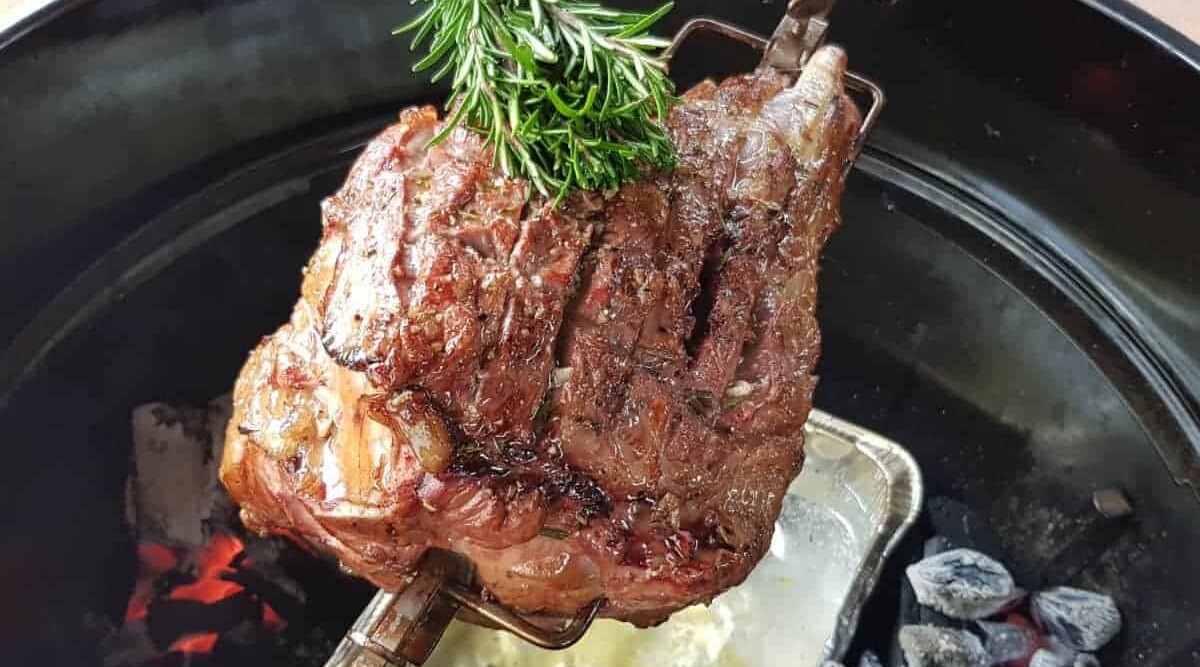
You may think water and smoke don’t mix, but when it comes to low and slow smoking in your own backyard, a water pan may be your best friend.
But why would you use one? And how? And when? So many questions…
I’ve been using a water pan for many years in my Weber kettle when smoking things like brisket, pork shoulder, and ribs. And I own and use a Weber Smokey Mountain that comes with one built in and it is highly recommended to use the water pan every time.
The logic I use is that water adds moisture to your cook — and while that is true, there are many other possible reasons why you might want to use a water pan in your grill.
Read on to learn more.
Key Takeaways
- Using a water pan in your smoker can bring benefits, including stabilizing the cooking temperature, keeping the meat moist and tender, blocking direct heat and flames to prevent burning, and enhancing the smoke flavor.
- In my experience and tests, I’ve found that using a water pan does noticeably result in moister, more tender meat, and a stronger smoky flavor.
- Where to place the water pan depends on the type of cooker you have. Some smokers come with built-in water pans, while others require positioning the pan between the heat source and the meat.
- Water pan use is ideal when cooking at a constant, low temperature for a long period, such as when smoking ribs, pork shoulder, brisket, or prime rib.
- A water pan is not necessary when cooking at high heat for a short period, like searing a steak. It may also prevent the skin of poultry from getting crispy.
- Water is the only recommended liquid to use in the water pan. I have experimented for years and found that other liquids (beer, juices) do not add any flavor to the meat.
- Expert tips for using a water pan include using hot water, filling the pan only halfway, avoiding placing fatty foods over the pan, and allowing the water to cool before removing the pan.
Jump to:
Why Use a Water Pan?
As mentioned in the intro there are numerous reasons to want to use a water pan while cooking barbecue, all of which can help to get a better end result.
It Stabilizes the Cooking Temperature
A water pan helps to keep a stable temperature inside your smoker. This is because water takes longer to rise or fall in temperature than air. So once the water comes up to temperature, it will radiate heat upwards into the grill if the air temperature begins to fall, and absorb excess heat and use it for evaporation if the grill starts to get too hot.
Also, water boils at 212 °F, so a large pan of water is a good fail safe mechanism to keep your smoker sitting low 200’s degrees even if your fire has raced off and become too large and hot; All that extra heat will simply be absorbed and used to boil off water.
Craig “Meathead” Goldwyn, a New York Times bestselling author, and creator of the website AmazingRibs.com, has a good read on this topic.
It Keeps the Meat More Moist and Tender
A water pan sits either over the flames or heat source, or at least right beside it. This causes the water to evaporate, making steam and creating a moist environment in the cooking chamber where your meat is cooking. This in turn prevents the meat from drying out during the cook, or at least helps the meat retain more moisture.
Similar to us when we are sweating in a humid environment, if there’s too much moisture in the air our sweat does not evaporate. The same happens with meat. If the cooking chamber has a high humidity, less evaporation occurs at the meat surface, so more moisture is retained inside the meat, which keeps it more moist and tender come eating time.
Check out the video below where James Beard Award-winner Aaron Franklin of famed Franklin Barbecue drops an awful lot of BBQ knowledge. Perhaps most importantly, he explains in a small backyard grill the heat source is very close to the meat and a water pan will assist in keeping the air inside the cooking chamber moist and keep the food from burning or drying out.
It Blocks Direct Heat / Flames
If you use a smoker like a Weber Smokey Mountain (which you can learn more about in our review), your water pan will be directly below the meat, and directly above the charcoal.
This is a barrier between the meat and the heat, and will eliminate direct heat and flames from potentially burning the food, as well as eliminate potential flare-ups caused by dripping fat falling onto your charcoal.
It helps to Get a Deeper and Better Smoke Flavor
As a grill heats up, any water from a pan will begin to evaporate and then condense on the colder surface of any meat being cooked, especially if it’s straight from the fridge.
When the steam condenses into water on the meats surface, it will mix with the rub on the surface and make the food “sticky.” This will make it easier for smoke particles — and smoke flavor — to adhere to the meat, and the result will be a better, smokier flavor.
There’s a great article here at genuineideas.com about how smoke is deposited onto meat. It clearly shows how smoke sticks better to moist surfaces, and a water pan helps massively in this respect.
Helps Create a Smoke Ring
If you want to get a good-looking BBQ smoke ring, then moisture in the air as you cook helps with this in a couple of ways.
If the surface of the meat remains moist, the formation of BBQ bark is delayed, allowing the meat pigments and proteins to remain in contact longer with the necessary gases required to make a smoke ring. Once a bark has formed, it creates a barrier between the meat and the air, and nitrogen in the air must contact the meat to form a smoke ring.
So a moist cooking environment helps promote a smoke ring, allowing more smoke and chemicals to absorb into the meat that helps the smoke ring formation.
Where Should You Place the Water Pan?
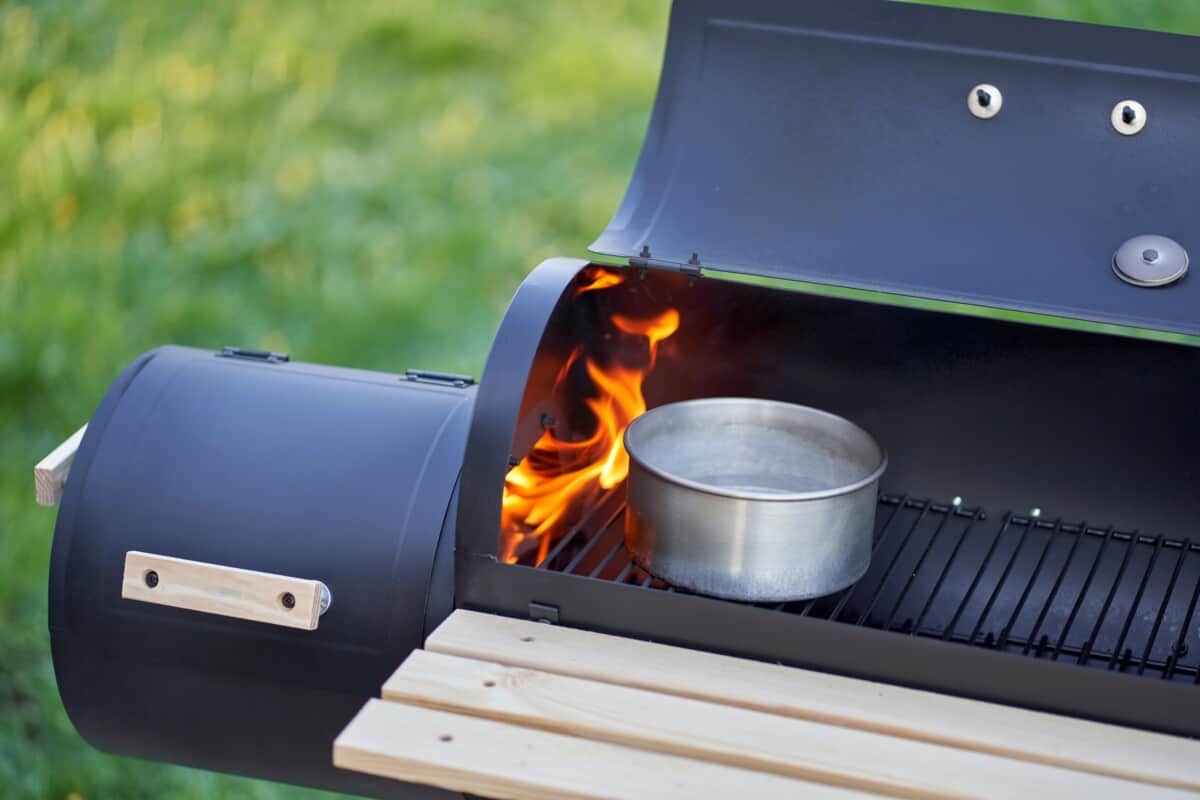
The biggest factor in deciding where to place your water pan will be the type of cooker you have and the amount of room you have to position your pan. Let’s look at a few different types of smokers.
Some Smokers Come with Water Pans Built in
Many smokers, such as the Weber Smokey Mountain vertical water smoker, most models of electric smoker, and many gas smokers have a water pan built in. So for these it’s simple, you put the water pan where the manufacturer says it should go.
In an Offset Smoker
In an offset smoker you position the water pan on the cooking grate between the firebox and the meat. This setup allows the hot airflow to hit the pan first before entering the cooking chamber, moderating the temperature around your meat.
In a Vertical Smoker or Kamado Grill
Most vertical smokers are ‘water smokers’ anyway, and will have a built in water pan that sits between the burning coals and the food racks. So of course you use this.
For kamado grills, a water pan isn’t really necessary. I have all 3 sizes of Kamado Joe grills and use them weekly. I can tell you from experience that using a water pan has no noticeable effect with these cookers. They are so sealed and so efficient at holding heat, that there is little airflow through them and the cooking chamber retains a ton of moisture from what evaporates off the meat alone.
If you do want to use a water pan with a kamado grill though, place it below the grates on top of the heat deflectors, so it is between the heat and the meat.
In a Charcoal Grill or Smoker
To use a water pan in a charcoal grill or smoker, prepare it for dual-zone cooking, which involves positioning the charcoal and wood chunks on one side and placing your water pan on the opposite side that is not over the heat source.
Alternatively, if your charcoal smoker is smaller, you might consider setting the water pan directly on the grill grate, between the food and the heat source.
In a Gas Grill or Smoker
For horizontal gas or electric smokers, arrange two-zone cooking by igniting only half of the burners. Place the water pan directly above these active burners. Then, position your meat on the grates above the burners that are not in use. This setup effectively utilizes indirect heat for cooking.
If you have a typical two- or three-burner gas grill, you can turn one burner on and leave the other(s) off. Place your meat on the “cold” side with a water pan underneath. This way the water in the pan can heat up to create even radiant heat sitting underneath your food.
When Should You Use a Water Pan?
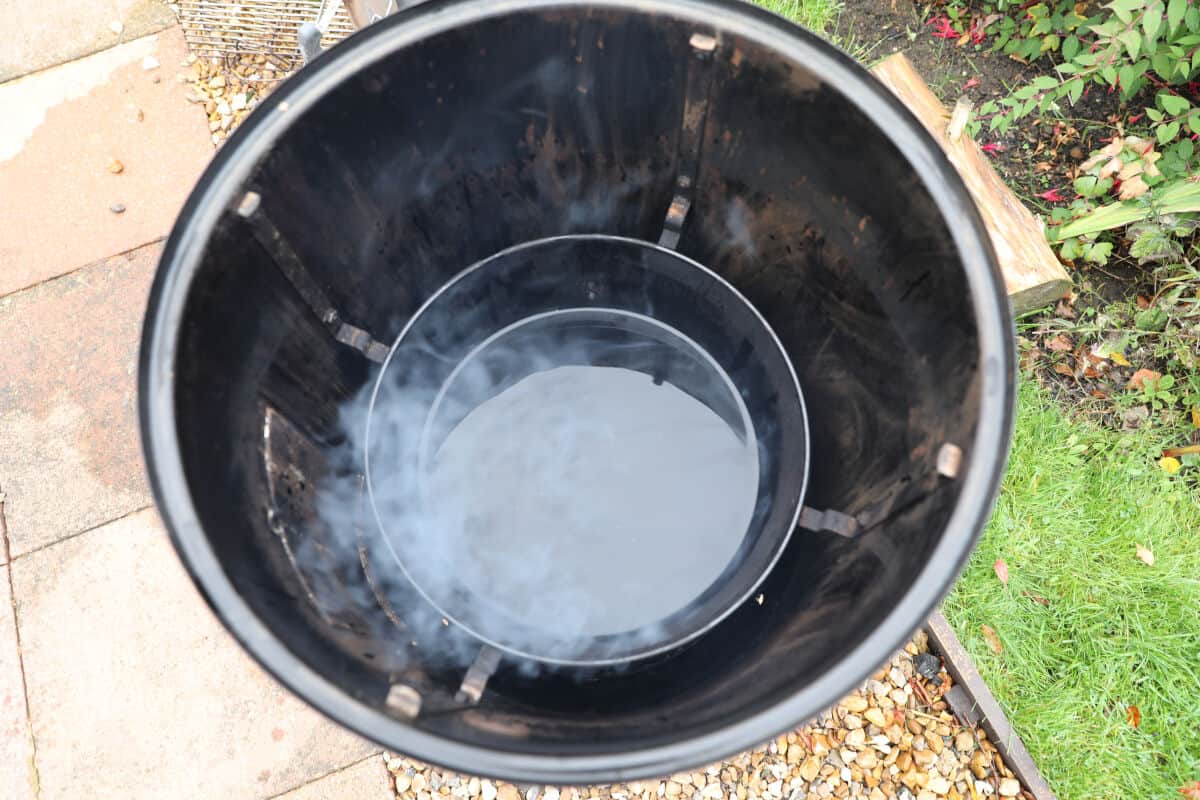
First of all, if your smoker comes with a water pan built in, you should use it. The manufacturers have designed their smoker to work this way, so it’s highly likely you’ll get the best performance from your smoker by following what the manufacturer advises, which is using the water pan.
When it comes to what you are cooking, anytime you are trying to cook at a constant, steady, low temperature for a long period is the ideal time to use a water pan.
It doesn’t matter what type of food you’re cooking, whether it be ribs, pork shoulder, brisket, prime rib, etc. If you’re going to be cooking at a low temp over a long period, you’ll benefit from a water pan.
When Shouldn’t You Use A Water Pan?
A water pan would be of little benefit anytime you’re cooking at a high heat for a short period — i.e. high heat grilling and searing.
If you’re going to be searing a steak at a high temperature the water in the water pan will boil rapidly and eventually evaporate altogether.
Also, if you’re cooking chicken, turkey, or any other poultry with the skin on, a moist cooking environment can keep the skin from ever getting crispy. And I don’t know about you, but I love a bit of crispy skin on my poultry!
Also, a water pan isn’t necessary with kamado grills. They keep the cooking chamber so moist anyway, that there’s no benefit to be had.
Can You Use Beer, Juices and Other Liquids Instead of Water?
Water is all that I believe should ever be used in a water pan. A lot of people like to use beer, apple juice, and other aromatic or tasty liquids in their water pans. And I’m sure it’ll smell good on your back patio, but this isn’t necessary and your food doesn’t benefit.
Since the point of the water pan is not to flavor the meat, but rather create a moist cooking environment with an even cooking temperature, the liquid will not have much impact on flavor. In fact, pretty much all that will happen is water in the liquid will boil away, leaving almost all the flavor behind in the pan.
I have experimented with using beers and juices and I absolutely have not ever been able to taste the difference on my meat. No extra flavor was created, I just wasted a decent beer/
I contend that if you want to use beer or apple juice to flavor your meat, you should place it in a spray bottle and spritz your food with it every couple of hours,. This way you’re able to make the meat “sticky” still to help smoke adhere, as well as add another layer of flavor to your food. Or you could use it as injection to get the flavor deep into the meat.
Expert Tips for Water Pan Use
Here are a few tips to keep in mind for smoker water pan use, to ensure you remain safe and get the best results:
- Always use hot, close to boiling water. You do not want to waste time and energy (fuel) heating up cold water in your grill or smoker, this just delays the time at which you are able to cook.
- Install your water pan and then fill it with water, to avoid potentially spilling the water onto the heat source, or worse onto yourself.
- Try not to place fatty foods over the water pan as fat dripping into the pan forms an oily layer on top of the water preventing evaporation, negating some of the benefits we are after.
- Only fill the pan about half way, so there’s way less chance of it boiling over into your smoker.
- When you’ve finished smoking, allow the water to cool before trying to remove the pan because the water will be hot and you could burn yourself.
Conclusion
How about you? Do you use a water pan when you barbecue low and slow? Do you just use a drip pan with no water? Do you just use water, or do you use another liquid in the water pan?
Leave a comment below telling us when and if you use a water pan, and how you use it.
If you’ve enjoyed this article, we hope you share it with your friends on Facebook to help us spread the word.


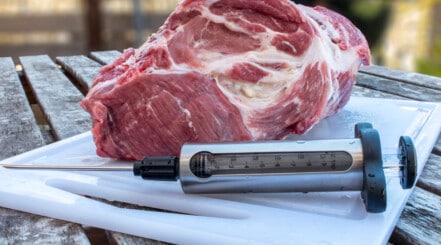
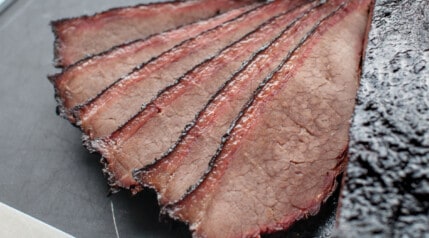
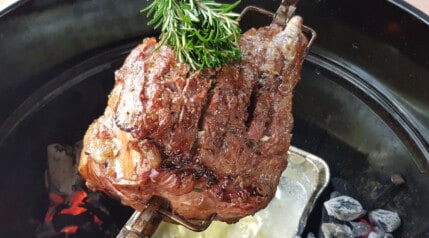
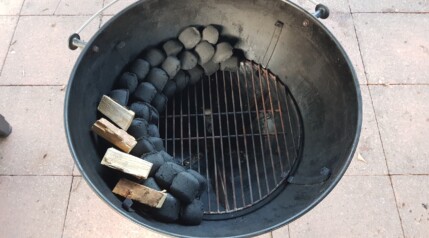
I have a ProQ smoker, similar to the Weber Smokey Mountain. I’ve always struggled to get the temp high enough when I’ve put boiling water in the pan from the start. I’ve started adding only a small amount of water at the beginning, which soon evaporates, then topping it up every couple of hours once its evaporated and the temp starts to raise too high. I usually have a flavored spray bottle at hand too.
Best bit of kit I’ve ever bought, once you’ve got the knack and worked out the best way that suits your particular smoker you’ll never look back.
Happy smoking folks 👌🏽🥩🍗🍖🍻
Love the ProQs, good bits of kit!
I’m still relatively new to smoking, so this may be a silly question. Do I still need to use a drip/water pan after I’ve wrapped my pork shoulder in heavy-duty aluminum foil for the stall and placed the meat back in the smoker? It seems counterintuitive to continue to use one since the meat is sealed in aluminum foil and moisture from the pan can no longer provide humidity for the meat. Thanks!
You’re right in your thinking, it really won’t make a difference at all as long as the temperature is stable.
The exception to this is electric smokers. I have a small “Apartment sized” 30″ Masterbuilt cabinet smoker. I start with the pan full of boiling water ( about 2 quarts ) since these smokers only have about a 1000 watt element, It really does help stabilize the tempter swings and get the temp back to normal after opening the door and I can see a much smaller variance between the top shelf and the bottom self of 4 through out the cook ( without water 15 to 18 deg F is normal between the lowest and highest self. Its about 4 or 5 degrees if I keep the water in the pan and add 180-210 deg water when its half gone) I have done as much as 4 12 lb Briskets in it but have found I have to rotate the racks every hour for the first 8 or so hours and every 2 or 3 hours after that hours to make them all cook. (rotate top rack to bottom slot then moving each of the other 3 racks up 1 slot) to do 4 x 12 lb briskets is about 26 hours for me.
Hi, Stanley.
Makes sense. I was a bit rash to say ‘makes no difference at all’, since a water pan stabilizes the temperature inside a smoker. I should have said makes no difference to moistness of the food once wrapped, but can still help with stable temps.
What about in a Kamado? I’ve read that these already do a great job of keeping meat moist. When I use a pan my skin/crust/bark never gets crisp.
Hi Drew,
It’s universally agreed by all that you do not need a water pan in Kamado. I own and use all 3 sizes of Kamado Joes and I never use one.
I understand that thin blue smoke does not add flavor to the meat. Still, it’s just an indication that your fire is burning at the right temperature, so the gas inside your cooking chamber can mix and mingle. Due to convection, when this warm air passes over the cold meat you’re trying to smoke, it becomes heavy, and the smoke settles on the meat.
I have been running offset smokers for the last 30 years and have had no trouble getting good smoked barbecue that is flavorful, tender, and smoky. Still, I have changed over to a pellet grill. By accident, I found some pellets that actually did create blue smoke. It was a shock to me because I had never seen blue smoke come out of my pellet grill in the 7 months I have owned it, but anyway, there’s this blue smoke. Hence, I whip up some ribs, throw them on a smoker, and smoke them for 5 hours, low and slow, at 130°.
Then I wrap them in foil and put them on the smoker for an hour and a half for 2 hours, and then I open them up and put a little barbecue sauce on them, and put them back on the grill without being wrapped to develop the color and set the bark and it was a picture-perfect creation that my smoker had made, but sadly there was no Smokey flavor.
No, you don’t want to put too much seasoning on your meat because it acts like a blanket and insulates the smoke from the meat…
I used the Spritz bottle just enough to keep the surface of the meat from drying out too soon.
It seems to me that if a wood can create enough blue smoke, wouldn’t one think there would be enough flavor in the wood to go around and flavor your barbecue?
I even heard that Less blue smoke is even better, so I made the fire a little bit hotter by bumping it up to 175 and tried smoking with less blue smoke and still no flavor from the wood.
My pellets have been stored in Tupperware with those snap-top lids to keep moisture out, but after I found out they were creating blue smoke, I took my hygrometer and put it in the Tupperware with the pellets and left it for a couple of days and came back and moisture content was 41%. Is that why I had no smoky flavor on my meat?
I’m throwing all these variables into the mix, and maybe someone will come up with something that I have presented to tell the doctors of smoke out there all these symptoms, and maybe y’all could put your heads together and keep me from banging my head on the wall.
Thanks for this article allowing people to learn how to squeeze flavor out of a pellet smoker.
I’ve talked to people standing right beside me at the smoker and they’re telling me i don’t have enough smoke coming out of the smokestack.. They’re wanting to see white smoke big billowing clouds of smoke..
I have pellets that I can put in the smoker that will create lots of white smoke.
I use a smoke tube in my pellet grill. Cost me $5 at Home Depot to make one. Will smoke for about 3 hours. Provides enough smoking time to get a good smoke flavor. I fill the tube full of pellets and use a propane torch to light it with. This is good for adding in different pellets for the smoke flavor you want, not having to commit to emptying your pellet box every time.
Bruce, Ive found that 200-225 is the sweet spot for my pellet smoker. Anything less doesn’t seem to create enough smoke to penetrate the meat properly. I’ve also changed over to the tan butcher paper instead of foil, as it is more permeable to both smoke and moisture, so more smoke gets in during long cooks, and (for those using water pans or a spritz) you can really make the most of your moisture source. Hope that helps, I’m still learning a lot too!
If all the water evaporates should more hot water be added during the smoking process?
Hi Kathy,
If you want the benefits it brings for the duration of the cook, then yes you would have to refill it if it boiled dry.
Thank you for your article I am new to smoking and need all the help I can get . 🍺
Will adding a moisture pan impact the creation of good bark in a smoke?
Hi Russ,
The increased moisture will help smoke to adhere to the surface of the meat during smoking, which helps with the bark and flavor. It also helps in water-soluble components of any rub you use dissolve (sugars and such) which can help with the bark. So yes, it can help. And the water in a pan (or more to the point, steam / humidity created) will not cause so much moisture that a bark doesn’t form. I have never had that happen.
Generally speaking I use a water pan most of the time in my WSM, or in a kettle grill when smoke roasting. I don’t bother in my kamados as they are so tightly sealed, the cooking chamber is moist enough due to the evaporation from the meat cooking.
I am a first time griller and still in a learning curve. If you would like to offer advice it would be much appreciated 😁
Hi Mary,
That’s exactly what this site is for and covers! Browse around and have a read, and if you have any questions after reading an article, fire away 🙂
I hear there is a pellet grill manufacturer coming out with a variable fan speed on it to control the airflow going through the smoker.
Could that possibly be the problem with the air entering your cooking chamber not having enough time to cool down before it decides to settle on your meat to add the flavor?
I had a guru on YouTube tell me the pellet grills put out less flavor because you’re using less wood. But there is certainly enough wood to create enough blue smoke for four pellet grills.
I have always thought about all that turbulence going through a pellet smoker.
You can smoke with an offset smoker with no wind feeding your draft. That gives the warm moist air a chance to cool down as it glides over your cold meat just from the natural convection of the fire in your smoker on an offset smoker.
If you preheat the wood you’re using for a smoker, it will catch fire sooner, bypassing the cooler temperatures of your growing fire bed that create white smoke. 650 up to 750°is the temperature when your fire starts to create blue smoke.
I still don’t think smoke in a pellet grill has enough time to linger in the cooking chamber to cool down enough to settle on the meat. That’s my story, and I’m sticking to it.
I’m new to BBQ in open flame. I was going to cook pork shoulder. Should I put the meat in the water pan, or above the water pan? My grill grate goes up to 32-36” high.
Above the water pan, Mike. If you put it in, it would be (partially) braising.
How far should I put the water pan from the coals? How far from the water pan to the pork shoulder?
Depends on what kind of smoker you have, but mostly it doesn’t matter. The water is there to help regulate temperature, and create a moist environment in the cooking chamber. No matter where it is in the cooking chamber it will achieve these goals. The water will evaporate and create a humid, moist environment, as well as prevent the smoker climbing much beyond the boiling point of water (in combinations with fire control aiming for low n slow, where you will only be cooking at 225 to 250F, so not many coals will be lit.)
But the general idea is to have your meat cooking indirectly, not above the heat source, or if it is then to have a water pan and even a deflector plate between the food and the heat source. In a WSM, upright smoker, or kamado style grill, the water pan will be under the meat, and they have set places to place the pan. In an offset it will be between the food and the firebox on the same grate. In a kettle grill it will be on the cooking grate over the coals, and the food NOT over the coals.
The water pan is an absolute must for big slabs of meat. I can put a liter and a half in mine. Not worried too much about water temp, so close to the heat, the temp comes right back up. The moisture keeps the meat moist, and you get that jiggly reaction when it is done cooking.
I find it definitely improves the end result when used in my WSM, so I always use water pan there. But I don’t bother with my Kamados as it’s so airtight it tends to have a moist enough cooking chamber simply from what evaporates off the meat while cooking.
I have an Oklahoma Joe combo grill with smoker where would I place a water pan and if I use a spray bottle to keep the food moist would that work just as well
Hi Richard. Typically, you put the water pan between the firebox and the meat, unless it’s a reverse flow then the opposite to that. And yes, spritzing does have much the same effect for the moisture, but you lose the effects of a water pan acting as a temperature regulator (not an issue at all if you already have temp control mastered though.)
Article makes sense to me. Just one thing I’m confused about. Does using a water pan replace spritzing or vice versa? Can both be done or is that overkill? I have a Camp Chef vertical XXL smoker.
Hello, I’ve smoked for a long time and always used water pan. I’ve always had the understanding the water pan keeps the meats moist. Now considering getting an Asmoke portable smoker for camping. Will I be disappointed in the final cook without water pan? Thanks, Wayne
Hi Wayne,
I honestly don’t think so, but there’s only one way to find out, which is to try it and see. I’m sure it will be fine though.
During a long cook on my Webber Smokey Mountain I usually need to add more boiling water. Is there a funnel that is food safe that will let me add it through the side door, so I don’t have to take the meat out allowing things to cool down? I’ve been popping the door out and then angling it into the water pan and pouring down the door. It seems to splash less water onto the coals than pouring it through the top. But it’s kind of awkward. What do you or others do?
Personally, I just take it apart to gain access to the water bowl, fill it and then put it back together.
Many people don’t even bother to use water in their WSMs, opting instead to fill the bowl with sand, or lava rocks, to increase the mass inside the smoker and help to regulate heat. They then wrap it in foil for easy cleaning.
Should you remove the water pan after you wrap your brisket
Up to you. It will have no further bearing on the meat itself, but will still act as a temperature regulator. So if you can keep your temps stable, you can and might as well remove it. But you could also keep it in to help stabilize temps.
I use a water pan under my roast low and slow.
With a bay leaf.
Then make gravy out of the pan afterwards.
I have an OKJ Bronco Pro. Have not tried using a water pan. Do you think it would help?
Hi James. I wouldn’t bother with a water pan in a drum smoker, they are well sealed and do a great job of maintaining a moist cooking environment and producing moist food without one, simply from moisture that initially evaporates from the meat.
I have the pit barrel cooker, and a friend has a drum smoker they built themselves. They hold a steady temp so well, and both of them have such a moist environment during a cook anyway that a water pan really isn’t necessary and won’t add much.
As with most things, I would recommend doing the same cook twice, once with and once without a water pan, to see if you think it’s worth it. Experimenting is fun!
What about reverse flow? Complementary flow?
Hi Jonathan. Can you elaborate?
Very informative thank you.
My question is, does smoke make its own moisture when using a smoker ?
To me, adding water in the water pan is unnecessary.
Water evaporates from the meat that is cooking, so if you have a highly sealed smoker (such as in a kamado, for example), the cooking environment remains relatively moist. But as discussed, the water pan also acts as a heat regulator.
I have a 4 in 1 pit boss smoker grill. The electric smoker has a built in water pan that sits between the heating element and food. I love it.
Hello Mark. I smoked my best brisket ever about 3 weeks ago. I used a water pan for the 1st time on my Big Green Egg along with the deflector. Not saying that the water pan was the “difference maker”, but the meat was moist! Today (4/3/22) I’m trying the water pan technique on a pork butt roast. I’ll let you know how it turns out.
Hi Larry,
I’ve never felt the need to use water pans with my Kamados, as the cooking chamber in a kamado is so airtight it stays a very moist environment anyway. It’s a matter of personal preference though. Let me know ho you get on?
I’ve never smoked my own pork belly to make bacon and I am still learning all this smoking techniques. I have a Masterbuilt electric smoker, when smoking bacon should I put water in the pan?
I wouldn’t use a water pan when smoking bacon, because you actually want it to dry out a little.
For the Masterbuilt box smokers there is an addon kit for “Cold smoking” under 100 deg that is amazing even for the low and slow cooks as well. I smoke a lot of sausages cheese fish and pack them in the freezer to cook later especially in the winter time when it stays sub 40 deg F in the smoker with the side attachment providing smoke: Masterbuilt Cold Smoke Box.